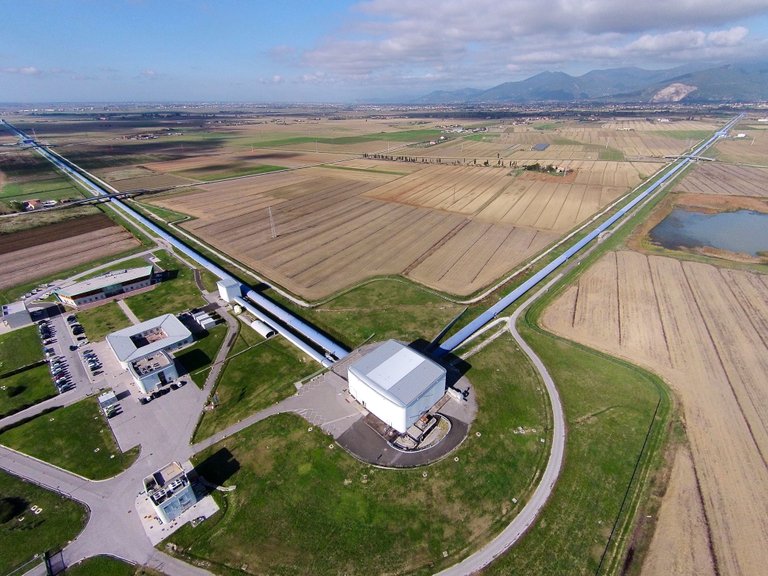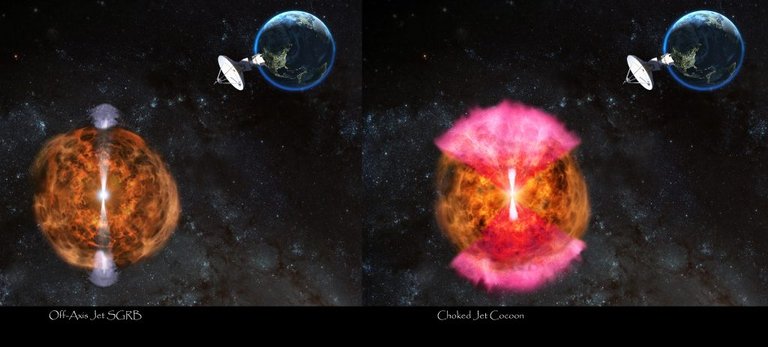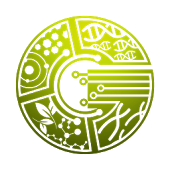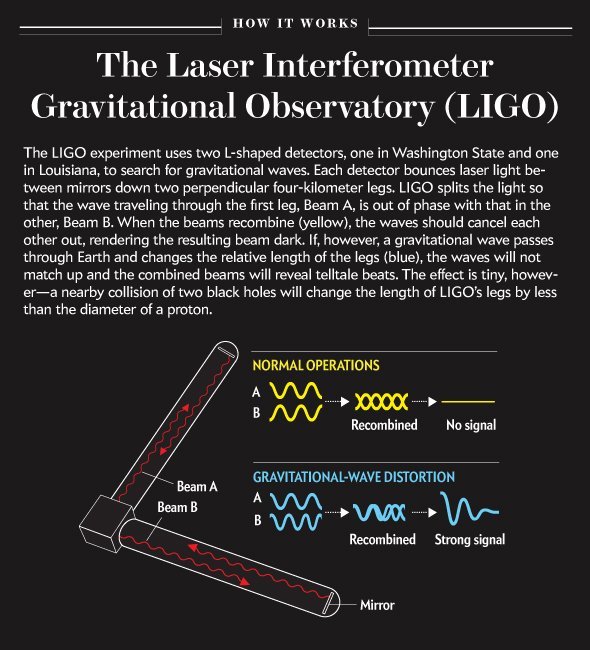
Gravitation, something we all know about, and at times even hate when we step up on that scale of ours in the morning. Gravity is the force that keeps us bound to our home, keeps us safe. It’s also such a strong force that it can make ripples in space, something Albert Einstein predicted long before it was possible to detect.
When two massive bodies collide, the gravitation created by this event is so enormous that it creates ripples in space. Like a pebble in a pond, the waves go on and on in space. As matter doesn't hinder them; the waves pass through space for eternity.
Ever since Einstein's prediction of said waves in 1916, scientists have tried to test his theory in reality. But there was no way of verifying this theory since gravitational waves are so very tiny ripples that no instrument could detect them. It was not until late 20th century that devices were even remotely capable of detecting these waves. LIGO and Vigo were created to catch these, or so they thought.
The two observatories
Today we have two observatories capable of detecting gravitational waves. One is LIGO in Pasadena California, US, the second one is Virgo in Pisa, Italy. Both are high features of engineering, as they are built to observe the small changes in space as gravitational waves pass through the earth. These tiny differences are less than one ten-thousandth the diameter of a proton, or less than the size of a soccer ball compared with the span of the Milky Way.
The instruments consist of long tubes, approximately 4km in length, in which there are laser beams that reflect in the other end and read by sensors at the hub where it started. It is by these tiny changes in laser frequency that scientists can detect the waves of gravitation.
LIGO
In August 2002, LIGO started up in the US, as the first instrument for trying to find signs of gravitational waves. Funded by National Science Foundation while built and operated by Caltech and MIT. It consists of two observatories, LIGO Hanford Observatory and LIGO Livingston Observatory.
Both observatories where closed for upgrades in 2008, and after seven years, opened up again in 2015 as the new "Advanced LIGO".
Virgo

Aerial view of Virgo in Italy
In 2003, Virgo was the second instrument. Virgo is a joint project by CNRS and INFN, located in Santo Stefano a Macerata, Italy.
In 2011, Virgo was also decommissioned for an upgrade, and replaced by "Advanced Virgo", completed in 2016. Now using the second generation of detection instruments as well.
The Findings
On September 18, 2015, the new upgraded and now Advanced LIGO, was set to start up the new experiments again. But already four days before that, the detectors found patterns of waves going through the array. At this time, the European station Virgo was yet still upgrading, and the signals weren't confirmed by anyone else.
But in 2017, Virgo joined in after their upgrades, and they joined in search of detecting the waves. On August 14, 2017, they both found a signal and GW170814 where observed. The first binary black hole merger detected by both stations together.
The observation was the first detection of a merger of two black holes ever, and only the fifth of gravitational waves, both jointly between the two observatories and singlehandedly as one of them have been in upgrades.
The last run ended in August 2017, as both the observatories are upgraded with even better sensors, expecting a then folded increase of sensitivity again. In 2018 there are more joint observations planned on an even more regular basis.
“This is just the beginning of observations with the network enabled by Virgo and LIGO working together. With the next observing run planned for late 2018, we can expect such detections weekly or even more often,” says David Shoemaker, a physicist at the Massachusetts Institute of Technology in Cambridge and spokesperson for the LIGO collaboration.
Radio waves came afterward, detected by the VLA (Very Large Array)
As the even of the merger created large waves of gravitation, detected by LIGO and Virgo in August, the event also sent out massive bursts of gamma rays, X-rays, and visible light. The VLA discovered the first radio waves coming from the event on September 2. The observation was the first time any astronomical object where detected with both gravitational waves and electromagnetic waves.
Together with several different observational stations, the astronomers were able to detect that the radio waves that came in later than the gravitational waves meant that their theories of the event were not what they had expected.
As the radio waves were not decreasing but increasing, there was something more to this than a disc with two jet streams directed outwards. Instead, after further analyze, the astronomers were able to accurately say that the event had made an expanding cocoon, absorbing the jet energy.
Watch a quick, yet well described video, about this event
by Tim Darnell on Deep Astronomy
by Tim Darnell on Deep Astronomy

Left side is the predicted, jet-propelled outbursts, where radio waves would get weaker after time. Right side is the observed, and reported in September, actual event with a cocoon, which emits Z-rays and radio waves over a more extensive angle
View Larger Image
View Larger Image
Einstein@Home - Finding new Pulsars and Waves
In 2005, the BOINC project Einstein@home started up. The project uses research data collected and enables personal computers of any kind to join in the analysis of collected data from the Arecibo Observatory and Parkes Observatory.
The project searches for both neutron stars, and new pulsars and gravitational waves.
- With data from LIGO gravitational-wave detectors, from large radio telescopes, and from the Fermi Gamma-ray Space Telescope they search for neutron stars by their pulsed radio and gamma-ray emissions.
- With data from data from the Arecibo Observatory, and in the past data from Parkes Observatory, searching for radio pulsars
Since the start of the project, more than 50 pulsars have been detected by this project alone, thanks to volunteering computer power.
Join Einstein@Home

Gridcoin Research is a Proof-of-Stake cryptocurrency that rewards research done on the distributed BOINC platform. Today, 26 projects can be attached and gain rewards for work, where Einstein@home is one of these projects.
What are the odds, just imagine...
Neil deGrasse Tyson describes this very good in his book Astrophysics for People in a Hurry
1.3 billion light-years away, in a galaxy far away, two black holes collide, at a time that our earth was inhabited by single cell organism. After another 800 million years, earth forms complex life, with a branch we now call mammals. Among the mammals, a sub-branch called primates evolves with larger frontal lobes and complex thinking.
Among these primates, homo-sapiens forms, that develops speech, agriculture, art and science, all in the last 10 000 years. In the last 200 years, one of those invents the theory of relativity, out of his head, and predict the existence of gravitational waves. Just a century later, technology capable of seeing these waves is invented and applied. Which finds these waves, just days after its startup.
Pretty mind blowing, yet amazing!
Reminds me of one of the best space series ever made :)
Sources
- Scientific American
- Wikipedia LIGO
- Wikipedia Virgo
- Wikipedia Einstein@Home
- Wikipedia Gravitational Wave
Join Gridcoin Research+BOINC and Change the World

BOINC (Berkeley Open Infrastructure for Network Computing, pronounced /bɔɪŋk/ – rhymes with "oink") is a distributed work platform that has been around since 2002 (15 years now) and rewards all participants with a score. BOINC consists of over 500,000+ active users and many more computers. It is a popular platform for researchers to do large amounts of distributed work. The infrastructure is already in place, and no payment is required. Doing distributed work is purely voluntary, where users can attach any project of their choosing.

Gridcoin Research is a Proof-of-Stake (PoS) cryptocurrency that rewards Proof-of-Research (PoR) for BOINC computation based on the BOINC RAC (Recent Average Credit) score. Some requirements are for projects to be listed on the platform but are relatively easy to comply. There are currently ~20+ Projects included that the network rewards work done by users.
Vote for me as Witness
Enjoy what I contribute to the community? Consider voting for my Witness on Steemit or BitShares. You can also vote for me as a Steemit Proxy Voter.
By voting for me as a witness, you will support an active witness on Steem and BitShares.
Read my Witness Posts: BitShares, Steemit



Very interesting article @sc-steemit! Einstein@home is one of the Gridcoin projects where you can use just any device whether it is CPU, GPU or Android. I really like this project.
I found the post very interesting, we are getting there
Since LIGO has two operational sites, with VIRGO there are now three. This will result in much improved directional resolution (solid angle uncertainty) for the detected events.
This gave me goose bumps when the news hit of this detection. There have been a number of other ones since. Only the beginning of a brand new field of astronomy. This will be especially fruitful with cross instrument correlated studies.
You really know your shit!
I'm also a Space enthusiast and I really believe 2018/2020 will be great for Science. Whether because of public institutions like NASA or CERN's LHC, or private ones like Elon Musk's SpaceX and whatever he's been working on! This guy is gonna change our world (even more than he already has)!
This is some next level stuff.

Hi, I found some acronyms/abbreviations in this post. This is how they expand:
Best Space Series? You mean Mass Effect? (The trilogy forget Andromeda, and give my Shepard back).
This project of yours seems great, but I wager you need good hardware to really do something, much like mining, right?
Cheers
I am the top contributor to the Einstein@home project worldwide, and I run it on all types of hardware - some a decade old!
Let me know if you have any questions about optimising yours.
Hmm, I may actually take a look at this. Going to check out the website.
I will have few questions also. :-) Once I get wallet on my Linux machine set up and working.
On the contrary, as @parejan writes, this is one project that any device can be used. Even old Android devices.
So, Einstein@home is the best project for weaker computers? Thanks for this info, I will stick with it then. Has nice & informative screen saver also. I will have few questions for you, dutch, parejan and other experienced members. After first day I'm showing 0.05 GRC per day. Probably should be more, even with weaker computer, correct? I haven't link wallet to it yet(downloading blocks and updating), haven't ask for seed coin donation yet and I haven't sent beacon out or whatever it is, all so confusing lol When i get seed donation, will my earnings increase or I need to tweak settings to increase the rate, or is rate normal for weaker computer with integrated graphic card?
As of witnesses I will later today vote for you when on another computer where I have active key. I already vote for 8 witnesses that are bellow top 50 and I have 5-6 votes left to use.
It even uses the Intel GPU on my old i5 laptop :)
Did someone say Ripple?
This post has received a 0.78 % upvote from @drotto thanks to: @steemstem-bot.
Well done! This post has received a 11.11 % upvote from @litasio thanks to: @steemstem-bot. Whoop!
If you would like to delegate to the @LitasIO you can do so by clicking on the following links: 50SP, 100SP, 250SP, 500SP. Be sure to leave at least 50SP undelegated on your account.
COIN MAN says... The Speed of Sight is

much faster than the Speed of Light...
COIN MAN by @pocketechange